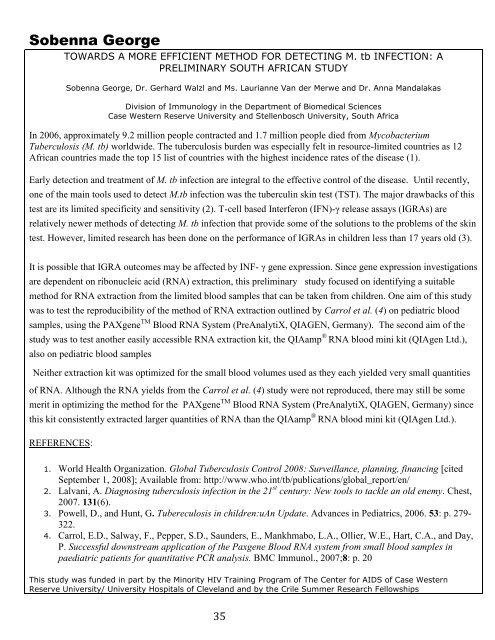student research day - Case Western Reserve University School of ...
student research day - Case Western Reserve University School of ...
student research day - Case Western Reserve University School of ...
Create successful ePaper yourself
Turn your PDF publications into a flip-book with our unique Google optimized e-Paper software.
Sobenna George<br />
TOWARDS A MORE EFFICIENT METHOD FOR DETECTING M. tb INFECTION: A<br />
PRELIMINARY SOUTH AFRICAN STUDY<br />
Sobenna George, Dr. Gerhard Walzl and Ms. Laurianne Van der Merwe and Dr. Anna Mandalakas<br />
Division <strong>of</strong> Immunology in the Department <strong>of</strong> Biomedical Sciences<br />
<strong>Case</strong> <strong>Western</strong> <strong>Reserve</strong> <strong>University</strong> and Stellenbosch <strong>University</strong>, South Africa<br />
In 2006, approximately 9.2 million people contracted and 1.7 million people died from Mycobacterium<br />
Tuberculosis (M. tb) worldwide. The tuberculosis burden was especially felt in resource-limited countries as 12<br />
African countries made the top 15 list <strong>of</strong> countries with the highest incidence rates <strong>of</strong> the disease (1).<br />
Early detection and treatment <strong>of</strong> M. tb infection are integral to the effective control <strong>of</strong> the disease. Until recently,<br />
one <strong>of</strong> the main tools used to detect M.tb infection was the tuberculin skin test (TST). The major drawbacks <strong>of</strong> this<br />
test are its limited specificity and sensitivity (2). T-cell based Interferon (IFN)-γ release assays (IGRAs) are<br />
relatively newer methods <strong>of</strong> detecting M. tb infection that provide some <strong>of</strong> the solutions to the problems <strong>of</strong> the skin<br />
test. However, limited <strong>research</strong> has been done on the performance <strong>of</strong> IGRAs in children less than 17 years old (3).<br />
It is possible that IGRA outcomes may be affected by INF- γ gene expression. Since gene expression investigations<br />
are dependent on ribonucleic acid (RNA) extraction, this preliminary study focused on identifying a suitable<br />
method for RNA extraction from the limited blood samples that can be taken from children. One aim <strong>of</strong> this study<br />
was to test the reproducibility <strong>of</strong> the method <strong>of</strong> RNA extraction outlined by Carrol et al. (4) on pediatric blood<br />
samples, using the PAXgene TM Blood RNA System (PreAnalytiX, QIAGEN, Germany). The second aim <strong>of</strong> the<br />
study was to test another easily accessible RNA extraction kit, the QIAamp ® RNA blood mini kit (QIAgen Ltd.),<br />
also on pediatric blood samples<br />
Neither extraction kit was optimized for the small blood volumes used as they each yielded very small quantities<br />
<strong>of</strong> RNA. Although the RNA yields from the Carrol et al. (4) study were not reproduced, there may still be some<br />
merit in optimizing the method for the PAXgene TM Blood RNA System (PreAnalytiX, QIAGEN, Germany) since<br />
this kit consistently extracted larger quantities <strong>of</strong> RNA than the QIAamp ® RNA blood mini kit (QIAgen Ltd.).<br />
REFERENCES:<br />
1. World Health Organization. Global Tuberculosis Control 2008: Surveillance, planning, financing [cited<br />
September 1, 2008]; Available from: http://www.who.int/tb/publications/global_report/en/<br />
2. Lalvani, A. Diagnosing tuberculosis infection in the 21 st century: New tools to tackle an old enemy. Chest,<br />
2007. 131(6).<br />
3. Powell, D., and Hunt, G. Tubereculosis in children:uAn Update. Advances in Pediatrics, 2006. 53: p. 279-<br />
322.<br />
4. Carrol, E.D., Salway, F., Pepper, S.D., Saunders, E., Mankhmabo, L.A., Ollier, W.E., Hart, C.A., and Day,<br />
P. Successful downstream application <strong>of</strong> the Paxgene Blood RNA system from small blood samples in<br />
paediatric patients for quantitative PCR analysis. BMC Immunol., 2007;8: p. 20<br />
This study was funded in part by the Minority HIV Training Program <strong>of</strong> The Center for AIDS <strong>of</strong> <strong>Case</strong> <strong>Western</strong><br />
<strong>Reserve</strong> <strong>University</strong>/ <strong>University</strong> Hospitals <strong>of</strong> Cleveland and by the Crile Summer Research Fellowships<br />
35
















